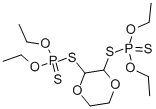Description
Dioxathion is a viscous, reddish-brown liquidor powder with a garlic-like odor. Technical product is amixture of cis- and trans-isomers. Molecularweight= 456.56; Boiling point = (decomposes).135℃;Freezing/Melting point = 220℃. Hazard Identification(based on NFPA-704 M Rating System): Health 3,Flammability 1, Reactivity 0. Insoluble in water.
Chemical Properties
dark amber viscous liquid
Uses
Dioxathion is an organophosphate pesticide. It is used as an insecticide on livestock and acaricide on citrus fruits.
Uses
Insecticide; acaricide.
Definition
ChEBI: Dioxation is a member of dioxanes.
General Description
Tan liquid (technical grade is brown). Used for the control of insects and mites on grapes, citrus, walnuts, ornamentals, apples, pears, and quince. Also used as a spray or dip for the control of ticks, lice, hornfly, and sheep ked on cattle, goats, sheep, and hogs.
Air & Water Reactions
Insoluble in water. DIOXATHION is stable in water at a neutral pH.
Reactivity Profile
DIOXATHION is heat sensitive. DIOXATHION may react with iron or tin surfaces. DIOXATHION may be hydrolyzed by strong acids or alkalis. . Organophosphates are susceptible to formation of highly toxic and flammable phosphine gas in the presence of strong reducing agents such as hydrides. Partial oxidation by oxidizing agents may result in the release of toxic phosphorus oxides.
Health Hazard
Very toxic. Probable oral lethal dose for humans is 50-500 mg/kg or between 1 teaspoonful and 1 oz. for a 70 kg (150 lb.) person. It is a cholinesterase inhibitor. Death is primarily due to respiratory arrest arising from failure of the respiratory center, paralysis of respiratory muscles, intense bronchoconstriction, or all three.
Fire Hazard
Shock can shatter container, releasing contents. (Non-Specific -- Organophosphorus Pesticide, Liquid, n.o.s.) Container may explode in heat of fire. Fire may produce irritating or poisonous gases. Runoff from fire control water may give off poisonous gases. Runoff from fire control or dilution water may cause pollution. When heated to decomposition, DIOXATHION emits highly toxic fumes of oxides of nitrogen, phosphorus, and sulfur. Avoid alkali materials and heat. DIOXATHION is unstable to iron or tin surfaces and when mixed with certain carriers.
Safety Profile
Poison by ingestion,
inhalation, skin contact, and intraperitoneal
routes. Mutation data reported. A
cholinesterase inhibitor. When heated to
decomposition it emits very toxic fumes of
POx, and SOx,. See also PARATHION
Potential Exposure
AgriculturalChemical; Tumorigen, Mutagen; Human Data. Thoseinvolved in the manufacture, formulation, or application ofthis insecticide and acaricide for control of insects andmites on grapes, citrus, etc.
First aid
If this chemical gets into the eyes, remove anycontact lenses at once and irrigate immediately for at least15 min, occasionally lifting upper and lower lids. Seek medical attention immediately. If this chemical contacts theskin, remove contaminated clothing and wash immediatelywith soap and water. Speed in removing material from skinis of extreme importance. Shampoo hair promptly if contaminated. Seek medical attention immediately. If thischemical has been inhaled, remove from exposure, beginrescue breathing (using universal precautions, includingresuscitation mask) if breathing has stopped and CPR ifheart action has stopped. Transfer promptly to a medicalfacility. When this chemical has been swallowed, get medical attention. Give large quantities of water and inducevomiting. Do not make an unconscious person vomit.Effects may be delayed; medical observation is recommended. Obtain authorization and/or further instructionsfrom the local hospital for administration of an antidote orperformance of other invasive procedures.
storage
Color Code—Blue: Health Hazard/Poison: Storein a secure poison location. Prior to working with thischemical you should be trained on its proper handling andstorage. Store in tightly closed containers in a cool, wellventilated area.
Shipping
Dioxathion requires a “POISONOUS/TOXICMATERIALS” label. They fall in Hazard Class 6.1 and inPacking Group II. This chemical is a regulated marinepollutant.
Incompatibilities
Incompatible with strong acids.Decomposes above 135℃, forming toxic oxides of phosphorus and sulfur. Attacks iron and tin surfaces.Hydrolyzed by alkalies. Dioxathion is hydrolyzed by strongbases; attacks iron and tin surfaces. Strong oxidizers maycause release of toxic phosphorus oxides.Organophosphates, in the presence of strong reducingagents such as hydrides, may form highly toxic and flammable phosphine gas. Keep away from alkaline materials.


